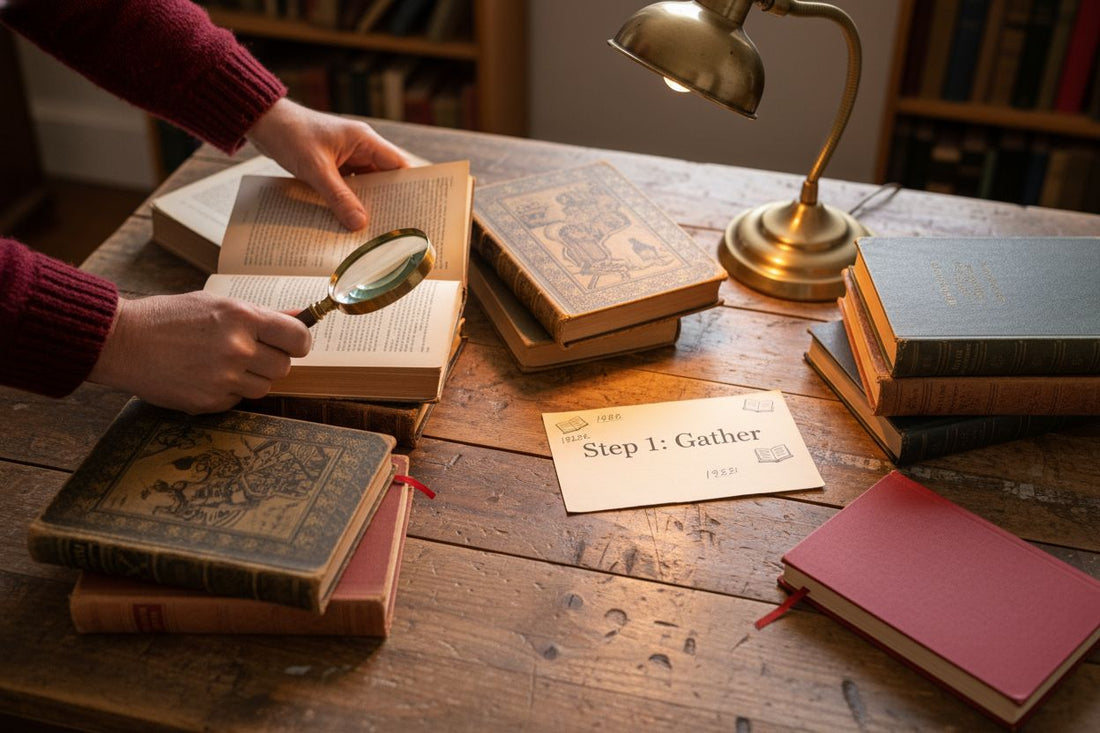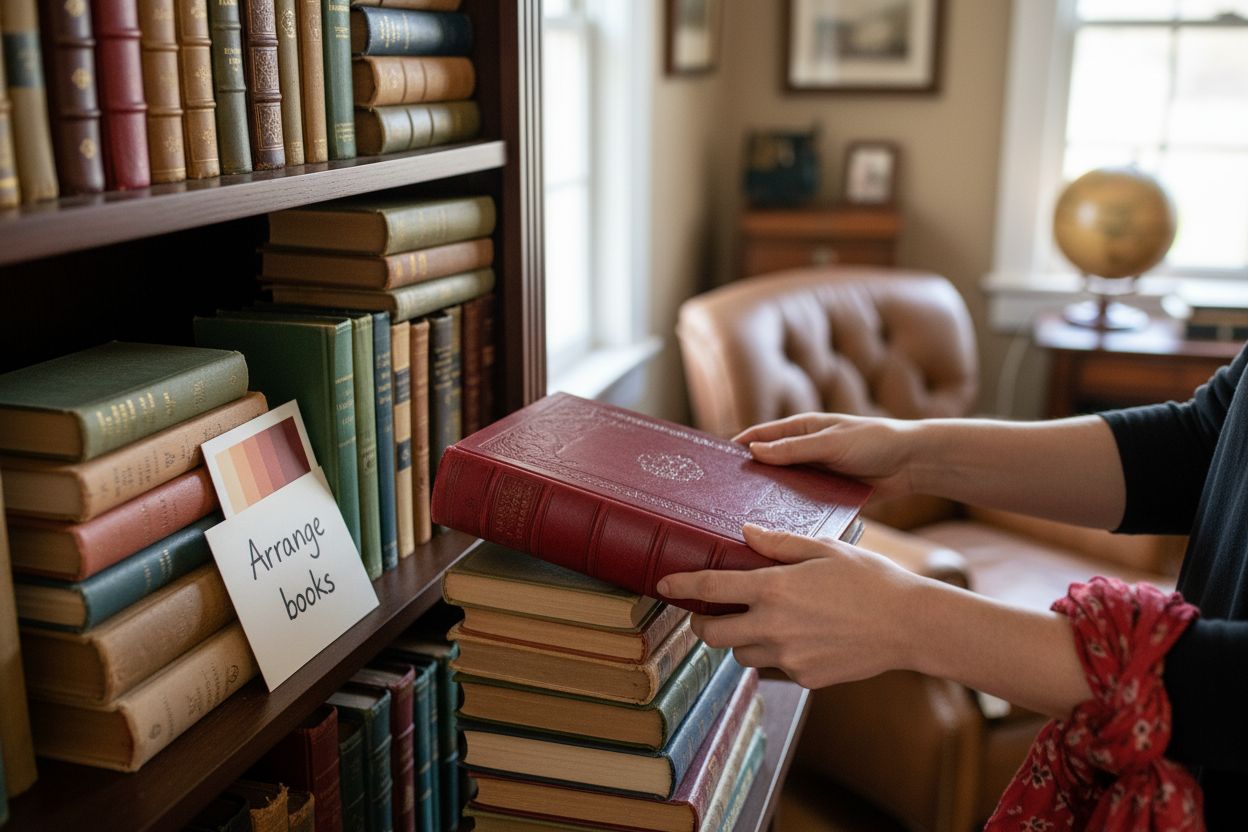
How to Display Vintage Books for a Nostalgic Touch
Share
Vintage books carry more than stories. They are actual pieces of history sitting quietly on your shelf, each with its own tactile charm and faded cover. But here is the surprise. Books published before the 1970s can have unique binding materials like leather, cloth, or even embossed designs you rarely see today. Most people think collecting is just about stacking old novels together. Actually, how you find, curate, and display these treasures makes all the difference and can turn a forgotten stack into something truly remarkable.
Table of Contents
- Step 1: Gather Your Vintage Book Collection
- Step 2: Choose A Suitable Display Area
- Step 3: Select Display Methods And Materials
- Step 4: Arrange Books For Visual Appeal
- Step 5: Add Complementary Decor For Enhancement
- Step 6: Verify Stability And Accessibility
Quick Summary
| Key Point | Explanation |
|---|---|
| 1. Curate a meaningful vintage collection | Start by selecting books that resonate with your aesthetic and interests, focusing on authenticity and historical significance. |
| 2. Choose a suitable display area | Evaluate spaces for light and humidity, ensuring conditions support book preservation and allow for aesthetic presentation. |
| 3. Use effective display methods | Employ strategies like stacking and angling books to create visual interest and highlight their unique features. |
| 4. Enhance with complementary decor | Add vintage items that harmonize with your collection, improving the narrative and aesthetic appeal of the display. |
| 5. Ensure stability and accessibility | Assess the display’s structural soundness and make books easy to view and handle, promoting both preservation and enjoyment. |
Step 1: Gather your Vintage Book Collection
Beginning your vintage book display journey starts with carefully curating a meaningful collection that reflects your personal aesthetic and nostalgic interests. Vintage books are more than just printed pages they are tangible pieces of history that carry stories, design elements, and cultural significance from different eras.
Searching for authentic vintage books requires patience and strategic exploration. Antique bookshops, estate sales, flea markets, and online marketplaces like vintage book dealers websites are excellent hunting grounds. Look for books published before the 1970s with distinctive cover designs, interesting typography, and well-preserved conditions. Pay special attention to books with unique binding materials such as leather, cloth-bound covers, or those featuring intricate embossed details.
When selecting vintage books, consider creating a focused collection around specific themes or genres. This might include mid-century science fiction novels, classic literature from particular decades, or books with remarkable graphic design elements from specific publishing periods. Condition matters significantly so examine potential additions carefully. Books should have minimal damage minimal foxing (age-related browning), intact spines, and no significant moisture or mold damage.
To ensure authenticity and preserve your collection’s value, learn to recognize genuine vintage editions. Research publication dates, printing marks, and publisher details. First editions and rare publications often hold more historical and collector’s value. If you are just starting out, read our guide on collecting retro tech for additional insights into curating vintage items.
Develop a systematic approach to collecting by establishing a budget, setting clear collecting parameters, and gradually building your collection. Remember that building a meaningful vintage book display is a journey of discovery and personal expression.

Step 2: Choose a suitable display area
Selecting the perfect display area for your vintage book collection requires thoughtful consideration of multiple factors that balance aesthetic appeal, book preservation, and overall room dynamics. The right location transforms your vintage books from mere objects into storytelling centerpieces that capture attention and spark conversation.
Carefully evaluate potential display spaces by examining natural lighting conditions, humidity levels, and temperature stability. Direct sunlight can cause significant damage to vintage book covers, causing fading and deterioration, so prioritize areas with indirect natural light or controlled ambient illumination.
Rooms with consistent temperature and moderate humidity between 30-50% provide optimal preservation conditions for your cherished volumes.
Consider architectural elements and existing furniture that can complement your vintage book display. Bookshelves, floating shelves, built-in wall units, and display cabinets offer structured presentation options. Vintage wooden shelving or mid-century modern furniture pieces create harmonious backdrops that enhance the nostalgic aesthetic. Avoid placing books near heat sources like radiators, fireplaces, or air conditioning vents which can cause rapid temperature fluctuations and potential material degradation.
Ergonomics and accessibility play crucial roles in your display strategy. Choose locations that allow comfortable viewing and interaction with your collection. Hallways, living rooms, home offices, and reading nooks present excellent opportunities for showcasing vintage books. If you are looking for additional inspiration for displaying collectible items, check out our vintage tech display guide for creative presentation ideas.
Ultimately, your display area should reflect personal style while providing a protective environment that preserves the historical and aesthetic value of your vintage book collection. Take time to experiment with different locations, observing how lighting, room layout, and surrounding decor interact with your carefully curated books.
Step 3: Select display methods and materials
Choosing the right display methods and materials transforms your vintage book collection from a simple assemblage of volumes into a curated visual narrative that captures historical elegance and personal storytelling. Strategic presentation techniques can elevate your books from mere objects to compelling artistic displays.
Consider multiple display approaches that showcase your vintage books’ unique characteristics. Horizontal stacking with varying book heights creates visual interest, while vertical arrangements allow spine details to become focal points. Mixing display orientations prevents monotony and highlights individual book design elements. Implement techniques like slight forward tilting or strategic angling to create depth and draw viewer attention to specific volumes.
Material selection plays a critical role in both aesthetic presentation and book preservation. Archival quality materials recommended by conservation experts ensure your vintage books remain protected while beautifully displayed. Opt for acid-free bookends, non-reactive metal supports, and archival quality shelving materials that prevent chemical degradation. Soft fabric book cradles or padded supports can prevent spine stress for more delicate vintage volumes.
Experimental display methods can transform your collection into an artistic statement. Consider transparent acrylic book stands that create floating illusions, vintage wooden book risers that add warmth, or minimalist metal supports that provide clean modern lines. Rotating your display periodically prevents prolonged exposure to light and keeps the presentation dynamic. Think of your vintage book collection as a living exhibition that evolves and tells a story through careful, intentional presentation.
Below is a table comparing different display methods and the recommended materials for preserving and showcasing your vintage books.
| Display Method | Description | Recommended Materials |
|---|---|---|
| Vertical Arrangement | Stand books upright to show off spine details | Acid-free bookends, archival shelving |
| Horizontal Stacking | Stack books lying flat in piles of varying heights | Padded supports, non-reactive risers |
| Forward Tilting/Angling | Angle books to highlight covers or unique features | Soft fabric book cradles, angled stands |
| Mixed Orientations | Alternate vertical and horizontal placement for interest | Minimalist metal supports |
| Transparent Stands | Use see-through supports for a “floating” look | Acrylic book stands, archival plastics |
| Thematic Clustering | Group books by genre, era, or design characteristics | Bookends with similar era finishes |
| Rotating Display | Periodically change book arrangement to prevent light damage | Photographic documentation, gloves |
Remember that documentation matters. Take photographs of your initial setup, allowing you to experiment and track how your display changes over time. Your vintage book display should not just preserve history but also reflect your personal aesthetic and connection to these remarkable literary artifacts.
Step 4: Arrange books for visual appeal
Arranging vintage books is an art form that transforms a simple collection into a captivating visual narrative. The goal is to create a display that tells a story through strategic positioning, color harmony, and design intrigue. Your arrangement should invite viewers to explore and appreciate the unique characteristics of each volume.

Begin by categorizing your vintage books according to visual attributes like color, size, and cover design. Create intentional color gradients that transition smoothly across your display, using book spines as a natural palette. Alternate between horizontal and vertical stacking to introduce dynamic visual rhythm. This technique breaks monotony and allows each book to be appreciated individually while contributing to a cohesive overall composition.
Consider the visual weight and balance of your arrangement. Place larger, heavier volumes as anchor points, using them to ground smaller books and create visual stability. Incorporate negative space between books to prevent visual clutter and allow each piece to breathe. If you are looking to enhance your vintage styling skills, explore our vintage style decorating guide for additional design inspiration.
Thematic clustering offers another compelling approach to book arrangement. Group books by era, genre, or design aesthetic to create mini-narratives within your display. Vintage science fiction titles from the 1950s, classic literature collections, or books with similar cover designs can be arranged together to tell a more focused story. Experiment with asymmetrical layouts that challenge traditional shelving conventions, creating visual interest through unexpected positioning.
Remember that your arrangement is not permanent. Periodically rotate books, adjust positioning, and refresh your display to maintain visual excitement. Treat your vintage book collection as a living, evolving art installation that reflects your personal aesthetic and appreciation for historical design. The perfect arrangement should not only showcase your books but also invite curiosity and spark conversations about the stories and eras these volumes represent.
Step 5: Add complementary decor for enhancement
Complementary decor transforms a basic vintage book display into an immersive storytelling environment that captures the essence of nostalgia and personal style. Strategic accessorizing elevates your collection from a simple arrangement to a curated narrative experience that engages viewers and reflects your unique aesthetic sensibilities.
Integrate vintage objects that harmonize with your book collection’s historical context and design elements. Antique reading glasses, vintage bookends, old typewriters, or period-specific writing instruments create compelling visual dialogues alongside your books. Look for accessories that share similar color palettes or design eras with your book collection, ensuring a cohesive and intentional presentation. Metallic objects like brass desk accessories or aged copper bookends can add warmth and textural contrast to your display.
Lighting plays a crucial role in enhancing vintage book displays. Soft, warm-toned lighting creates an inviting atmosphere that highlights book details and creates depth. Consider exploring our guide on layering retro lighting to understand how strategic illumination can transform your display. Vintage desk lamps, Edison bulbs, or soft amber-tinted light sources can create an intimate, nostalgic ambiance that makes your book collection feel alive and dynamic.
Photographic elements and artwork can further enrich your vintage book display. Vintage black and white photographs, literary-themed art prints, or framed book illustrations positioned near your collection create narrative connections and visual intrigue. Choose pieces that echo the aesthetic of your books, whether that means mid-century modern graphic designs or romantic Victorian-era illustrations.
Remember that complementary decor should enhance, not overwhelm. Each additional element should serve a purpose, contributing to the overall story and atmosphere. Treat your vintage book display as a living art installation that evolves and tells a personal story through carefully chosen objects and thoughtful presentation.
Step 6: Verify stability and accessibility
The final stage of creating your vintage book display involves meticulously assessing stability, safety, and accessibility to ensure your curated collection remains protected and enjoyable. Structural integrity is paramount when displaying delicate vintage volumes that represent historical and personal value.
Begin by conducting a comprehensive structural assessment of your display area. According to preservation experts at the Library of Congress, shelving must be robust, level, and capable of supporting the weight of your vintage books without risk of collapse. Use a spirit level to confirm horizontal alignment, and ensure mounting hardware or shelf supports are securely anchored. Pay special attention to weight distribution, placing heavier volumes on lower shelves to maintain balance and prevent potential toppling.
Accessibility involves more than physical reach it encompasses creating an interactive display that invites exploration while protecting fragile volumes. Position books at comfortable viewing angles, ensuring readers can appreciate spine details and cover designs without straining. Consider the height of your display in relation to different viewer perspectives children, seated individuals, and those with mobility challenges. Implement gentle book supports or angled risers that allow safe handling and visual appreciation without direct physical contact.
Implement protective strategies that balance accessibility with preservation. Use soft cotton gloves when handling particularly delicate volumes, and consider creating a designated viewing area with adequate lighting and clean surfaces. Develop a rotation system that allows periodic examination of books while minimizing prolonged exposure to environmental stressors. Create clear visual and tactile boundaries that communicate both invitation and respect for your vintage collection.
Document your display configuration through photographs and detailed notes. This documentation serves multiple purposes tracking your collection’s evolution, understanding display effectiveness, and creating a visual record of your curated narrative. Regularly reassess your display every few months, making subtle adjustments to maintain both aesthetic appeal and structural integrity.
Here is a quick checklist table to help you verify the stability and accessibility of your vintage book display for long-term preservation and enjoyment.
| Step | What to Check | Why it Matters |
|---|---|---|
| Assess Shelving Strength | Is the shelf robust and level? | Prevents collapse and damage |
| Secure Mounting Hardware | Are supports safely anchored? | Avoids accidental falls |
| Distribute Weight Evenly | Heavy books on lower shelves? | Maintains stability |
| Confirm Viewing Angles | Books easy to see and reach? | Enhances interaction |
| Use Protective Supports | Cradles/bookends in place? | Preserves delicate books |
| Rotate and Document Display | Setup photographed or logged? | Tracks changes and improvements |
| Schedule Regular Reassessment | Checked every few months? | Maintains preservation |
Take Your Vintage Display Even Further with OnlyRetro
Curating and showcasing nostalgic items like vintage books is a rewarding yet challenging journey. You want to honour personal stories and historical value while achieving visual elegance and protection for your collection. The right display elevates sentimental pieces, but finding authentic retro accents and technology that complement your aesthetic can leave you searching for specialised solutions.
OnlyRetro is the perfect partner for this next step in your nostalgic display. Discover retro-themed tech gadgets, unique home decor, and vintage-inspired accessories that fit right in with your classic book setup. Visit OnlyRetro for a curated selection bound to enhance your living space and complete the nostalgic mood. Ready to make your collection stand out? Explore the latest arrivals at OnlyRetro’s homepage and experience how the right finishing touches can transform your entire display. Start elevating your vintage look today before the best finds disappear.
Frequently Asked Questions
How do I choose the right display area for my vintage books?
Choosing the right display area involves assessing lighting and temperature conditions that can affect your books. Seek out locations with indirect natural light and stable humidity levels to help preserve your collection.
What materials should I use for displaying vintage books to ensure their preservation?
Utilize acid-free materials such as non-reactive metal supports and archival quality bookends. This will help prevent chemical degradation and protect your books, allowing you to maintain their condition over time.
How can I arrange my vintage books for optimal visual appeal?
To create an attractive display, categorize your books by color, size, or design and alternate between horizontal and vertical stacks. Incorporate negative space to avoid visual clutter, ensuring each book can stand out effectively.
What types of complementary decor can I add to enhance my vintage book display?
Integrate vintage objects like reading glasses, old typewriters, or period-specific writing instruments that align with your book’s historical context. These elements should enhance the storytelling aspect of your display without overwhelming it.
How can I verify the stability and accessibility of my vintage book display?
Assess the structural integrity of your shelving to ensure it supports the weight of your books and is level. Position books at comfortable viewing angles to invite exploration, and consider using gentle supports for delicate volumes to maintain easy access while preserving them.